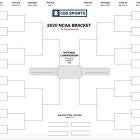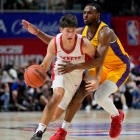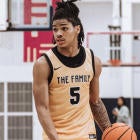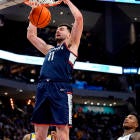The 2020 NCAA Tournament is not going to be played over concerns about the coronavirus (COVID-19) pandemic, but there is still a chance an official bracket for the field of 68 could be released by the NCAA.
NCAA senior vice president of basketball Dan Gavitt told CBS Sports on Friday that the NCAA has not yet completely killed the idea of putting together a 68-team bracket for the purposes of an official recognition of the 2019-20 men's Division I basketball season. While far from a sure thing, it's still on the table -- offering hope to coaches and players across the country that they could at least potentially get formal recognition for the work they put into their seasons over the past five-plus months.
"We're hearing today there's interest from coaches and athletic directors from that," Gavitt said. "I wouldn't say we've shut down the idea completely, but there is, practically speaking, it's a bit challenging at this moment. ... There's pluses and minuses to any decision. If you put the field together, you could have teams, depending on that conference's policy, would not be the most obvious choice as the [automatic qualifier]. It's something we're going to continue to look at.
"This has been so fast, so emotional, we'll continue to think on it a little bit."
Gavitt's comments come after high-profile coaches such as Bruce Pearl, Bobby Hurley, Kelvin Sampson and others have lobbied for a release of the bracket. If this was able to be pulled off in the coming days, it's unclear whether there would be a televised element to this or whether it would be released/unveiled through the NCAA's communications office.
The biggest challenge is the logistics. The selection committee for the men's Division I tournament said their goodbyes in New York late Thursday night. The 10-person panel is comprised of athletic directors and conference commissioners, all of whom are going back to their respective schools and leagues across the country to deal with their situations at home in regard to caution with the coronavirus.
Even though the committee members are no longer together, they could certainly communicate electronically and go through the seeding and selection process to build a bracket. It's a matter of the time, desire and consideration for every team that would be involved -- those who did get in and those who didn't.
The reason the idea hasn't completely died on the vine yet is the fact that the logistics surrounding the cancellation of the NCAA Tournament left this as a dangling thread.
With coaches, some media members and fans enthusiastic about the release of a bracket, it has remained a possibility -- even if a small one at this stage -- nearly 24 hours after the cancellation of the NCAA Tournament.
"There was some discussion about it; I'd say substantially," Gavitt said. "To put us into real time into what was going on yesterday: conference tournaments were being canceled, committee members were dealing with their own conferences and their own programs with where they were going and what decision they were making. All week there was a lot of distraction for everyone involved because of how rapidly all of this was evolving."
The selection committee only got as far as to send in their initial ballots, so as of early Thursday afternoon, there were 31 at-large teams in the field in addition to another 13 automatic qualifiers. Many of the 31 at-large teams would have inevitably taken up automatic-qualifier spots.
There was concern among the committee members that, because 19 conference tournaments were not completed, you have uncertainty there as to who should or would get the automatic qualifier. But Gavitt noted that every league is required to have in place a rule that allow for a conference to name an automatic qualifier for the NCAA Tournament in the event of that tournament not being able to hold or complete a league championship bracket.
"There actually is a mechanism for that because each conference is required to tell us how they would be given a conference AQ if the conference tournament was not completed," he said. "The conferences have to have that. It's required."
In some cases, it's the No. 1 seed in the league tournament; in others, it's the highest remaining seed in the tournament. Or it can be any other way a conference chooses to determine it.
When looking at schools like Dayton, Baylor, San Diego State and others -- teams projected on the top three seed lines that have had unusually terrific seasons -- Gavitt recognized that there are many programs who would take a little bit of reward in the aftermath of such an unfortunate but necessary decision.
"I understand both perspectives, first and foremost for the student-athletes knowing definitively where you are as an NCAA Tournament team, or a No. 1 seed," Gavitt said. "Not based on other bracketologists, but based on the selection committee's decision. That's a big deal. It's what they all play for and to have the kind of recognition and honor that comes with it."
This year will be the first that there is no NCAA Tournament since 1938. All winter and spring championships were canceled in the call with the NCAA's Board of Governors close to 4 p.m. ET on Wednesday, a vote that Gavitt said was a unanimous decision.

















